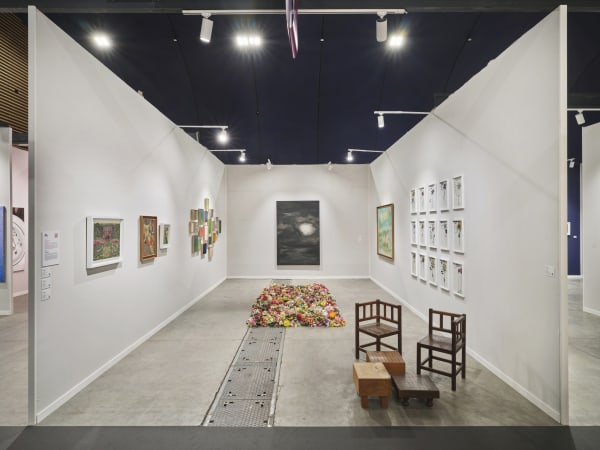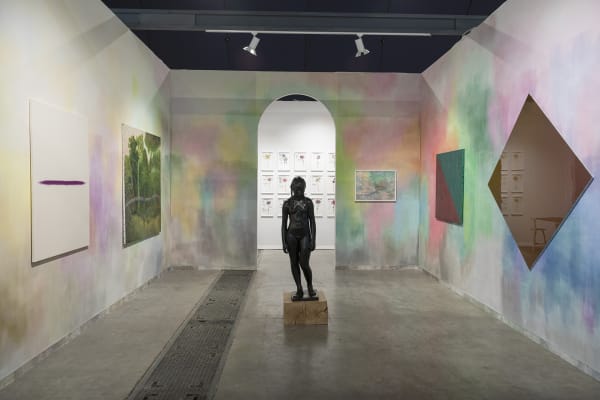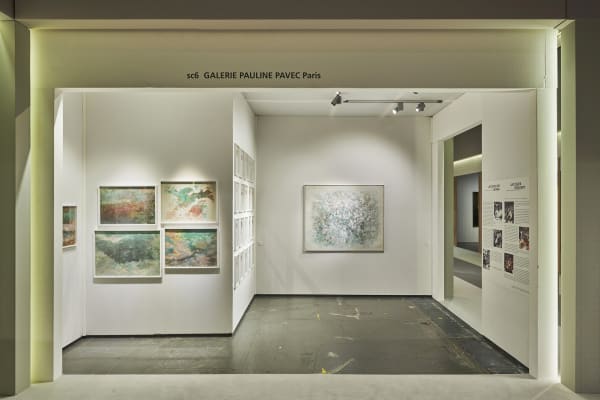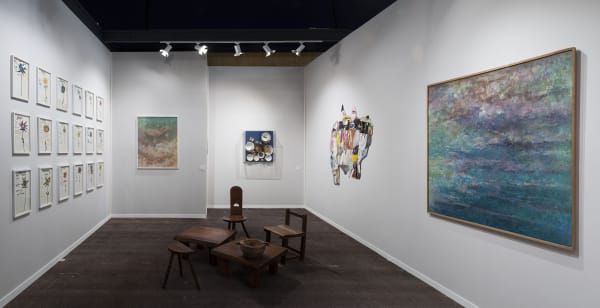« L'art, la poésie, c'est le précipité de la beauté dans l'émotion »
Orpheline très jeune, après des études aux Arts Décoratifs puis aux Beaux-Arts, Jacqueline Lamba commence une vie d'artiste indépendante. Elle est décoratrice au grand magasin des Trois Quartiers, puis devient danseuse au Coliséum à Pigalle. Elle publie des photographies, des aquarelles et crée des objets surréalistes. En 1934, elle épouse André Breton avec qui elle aura une fille et participe à des expositions à Paris, Londres et New York. En 1938, au cours d'un voyage au Mexique, elle rencontre Frida Kahlo et c'est le début d'une longue amitié. Au début de la guerre, elle se réfugie auprès de Dora Maar et de Picasso, puis chez Marie Cuttoli. En 1941, J. Lamba et A. Breton partent aux États-Unis. Peu après elle se sépare de lui « pour pouvoir peindre », et partage un temps sa vie avec David Hare, peintre et sculpteur avec qui elle a un fils.
Elle participe à deux expositions à la galerie Peggy Guggenheim Arts of this Century de New York dont « Exhibition by 31 Women » en 1943. C'est en 1944, à l'occasion de sa première exposition personnelle à la Norlyst Gallery qu'elle publie un Manifeste de peinture. Après son retour en France, elle expose à la galerie Maeght, puis à la galerie Pierre-Lœb. En 1951, elle fréquente Pablo Picasso, Françoise Gilot, Alberto Giacometti, Claude Cahun, et s'installe définitivement à Paris.
Sa dernière exposition, au musée Picasso en 1967, est inaugurée par Yves Bonnefoy. La lumière, le mouvement, la nature sont ses sources d'inspiration, tels Ciels (dès les années 1960), Fleurs d'eau (1978) et les nombreuses toiles sur le village de Simiane-la-Rotonde dans le Vaucluse où elle s'était installée.
Joëlle Guimier
Extrait du Dictionnaire universel des créatrices
© 2013 Des femmes - Antoinette Fouque
French painter (1910-1993)
Orphaned at a young age, Jacqueline Lamba began life as an independent artist after having studied decorative and fine arts. She was a decorator in the Trois-Quartiers department store, and then became a dancer at the Coliséum in Pigalle. She published photographs, painted watercolors, and created surrealist objects. In 1934 she married André Breton, with whom she had a daughter, and participated in exhibitions in Paris, London, and New York. In 1938, during a trip to Mexico, she met Frida Kahlo, and began a long friendship with the artist. At the start of World War II, she took refuge with Dora Maar and Picasso, then at the home of Marie Cuttoli. In 1941, she and Breton left for the United States. Shortly thereafter she separated from him “in order to paint”, and to share part of her life with David Hare, a painter and sculptor with whom she later had a son.
She participated in two exhibitions at Peggy Guggenheim’s Art of This Century gallery in New York, including the “Exhibition by 31 Women” in 1943. It was in 1944, on the occasion of her first solo exhibition at the Norlyst Gallery, that she published a Manifeste de Peinture (A Painting Manifesto). After returning to France, she exhibited at the Maeght gallery and at the Pierre Loeb Gallery. In 1951, she frequently visited Pablo Picasso, Francois Gilot, Alberto Giacometti, and Claude Cahun, finally settling permanently in Paris.
In 1966 she campaigned against the installation of nuclear missiles on the Plateau d’Albion, as well as the expansion of the Larzac military camp. Her last exhibition was held at the Picasso museum in 1967, and was inaugurated by Yves Bonnefoy. Light, movement, and nature were her sources of inspiration, as demonstrated in Ciels (“Skies” 1974), Fleurs d’eau (“Water Flowers” 1978), as well as numerous canvases of the village Simiane-la-Rotonde in the Vaucluse region where she had settled.
Collections Publiques
MOMA — Museum of Moden Art, New York, USA
Centre Pompidou — Musée National d'Art Moderne, Paris, France
MACVAL — Musée d'Art Contemporain du Val-de-Marne, Vitry-sur-Seine, France
CNAP — Centre National d'Art Plastique, Paris, France
Musée National Picasso, Paris, France
Musée Cantini, Marseille, France
Musée des Beaux-Arts du Canada, Ottawa, Canada
-

L'AVENTURE, CROQUEFRUIT
QUENTIN DEROUET 1 May - 8 Jun 2024Avec des œuvres de : ERIC BAUER - HANS BELLMER - VICTOR BRAUNER - ISABELLE DAËRON - MATHILDE DENIZE - OSCAR DOMINGUEZ- MARCEL DUCHAMP - AUBE ELLÉOUËT - JACQUES HÉROLD...Read more -

RÉSURGENCES
JACQUELINE LAMBA — ISABELLE DAËRON 9 Nov - 16 Dec 2023Lorsque j'ai découvert les oeuvres de Jacqueline Lamba, j'ai été interpellée par l'énergie de ses dessins, comme si la présence de l'eau vive dans ces paysages transfigurait l'environnement. En...Read more -

UN ARC-EN-CIEL EN PLEINE NUIT
JACQUELINE LAMBA 29 Mar - 14 May 2022L’art, la poésie, c’est le précipité de la beauté dans l’émotion. (Jacqueline Lamba) Les formes vont et viennent, naissent, disparaissent et resurgissent parfois, après des années ou des siècles, pour...Read more
Jacqueline Lamba, L’Amour fou d’André Breton, du nom de l’essai poétique que le fondateur du Surréalisme lui dédia, se consacra toute sa vie à la peinture dès sa formation à l’Ecole des arts décoratifs. Mariée à André Breton quelques mois après sa rencontre avec le poète en 1934 qui la décrit alors comme « scandaleusement belle », elle participe aux expositions du groupe surréaliste telle celle de la galerie Charles Ratton en 1936 où elle présente des poèmes-objets.
De Paris à New York en passant par le Mexique, son itinéraire la met en contact avec de nombreuses figures du groupe tandis qu’elle développe une amitié avec Dora Maar ou Frida Kahlo. Aux USA, puis après son retour en France en 1955 sa peinture s’écarte du surréalisme pour une approche plus abstraite où se ressent l’influence de Picasso.
C’est à partir des années soixante que son œuvre trouve son style définitif, une peinture de la lumière qui évoque la nature qu’elle a sous les yeux, en particulier dans le village des Alpes-de-Haute-Provence où elle passe les étés. Elle suggère sur la toile des ciels constellés de taches et de points lumineux. « Le secret, écrivait-elle, serait de capter sur une toile chaque forme dans sa lumière, c’est- à-dire au moment précis où la lumière devient la forme. Ce serait comme de voir un arc-en-ciel en pleine nuit. »
Alfred Pacquement,
Histoires naturelles : un regard sur la scène française,
Art Paris 2022
Jacqueline Lamba was André Breton’s L’Amour fou, to quote the title of the poetic essay dedicated to her by the founder of Surrealism. She studied at the École des arts décoratifs and went on to devote her whole life to painting. She married Breton only a few months after meeting the poet in 1934, who described her at the time as being “scandalously beautiful”. Lamba took part in the surrealist group exhibitions, such as the Exposition surréaliste d’objets at Galerie Charles Ratton in 1936, where she presented her object-poems.
Her many travels, from Paris to New York and Mexico, brought her in contact with numerous figures from the group and, in parallel, she forged friendships with Dora Maar and Frida Kahlo. In America and then after returning to France in 1955, her painting moved away from surrealism and adopted a more abstract approach in which the influence of Picasso was apparent.
She found her definitive style in the 1960s, painting light and evoking the landscapes she saw around the village in Alpes-de- Haute-Provence where she spent her summers. On the canvas, she suggested skies sprinkled with spots and points of light: “The secret, she wrote, would be to capture every form on the canvas together with its light, in other words at the very moment when light becomes form. It would be like seeing a rainbow in the middle of the night.”
Alfred Pacquement,
Natural Histories : a focus on the french scene,
Art Paris 2022
-

ART PARIS 2024
4 - 7 Apr 2024QUENTIN DEROUET — JACQUELINE LAMBA — FLORA MOSCOVICI — JACQUES PRÉVERT — JULIETTE ROCHE — AURÉLIA ZAHEDI ' Juliette Roche, quoiqu’ayant fait partie successivement des...Read more -

ART PARIS 2023
30 Mar - 2 Apr 2023ADAM BOGEY - MATHILDE DENIZE - QUENTIN DEROUET - JOSÉ GAMARRA - RENÉ ICHÉ - JACQUELINE LAMBA - JACQUES PRÉVERT - ROBERT MALAVAL - OLIVIER...Read more -

TEFAF MAASTRICHT 2022
24 - 30 Jun 2022JACQUELINE LAMBA - JACQUES PRÉVERTRead more -

ART PARIS 2022
6 - 10 Apr 2022ADAM BOGEY - MATHILDE DENIZE - JACQUELINE LAMBA - JACQUES PRÉVERT - DANIEL SPOËRRIRead more










